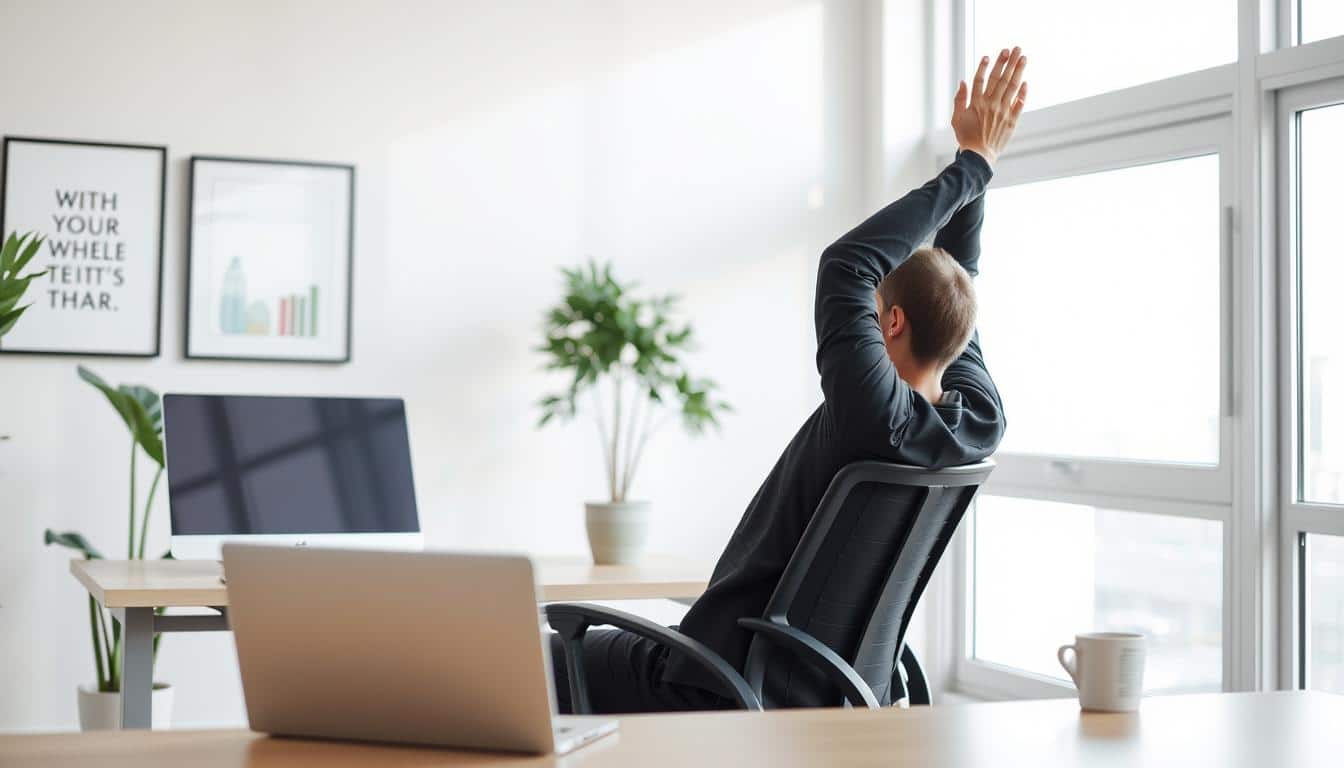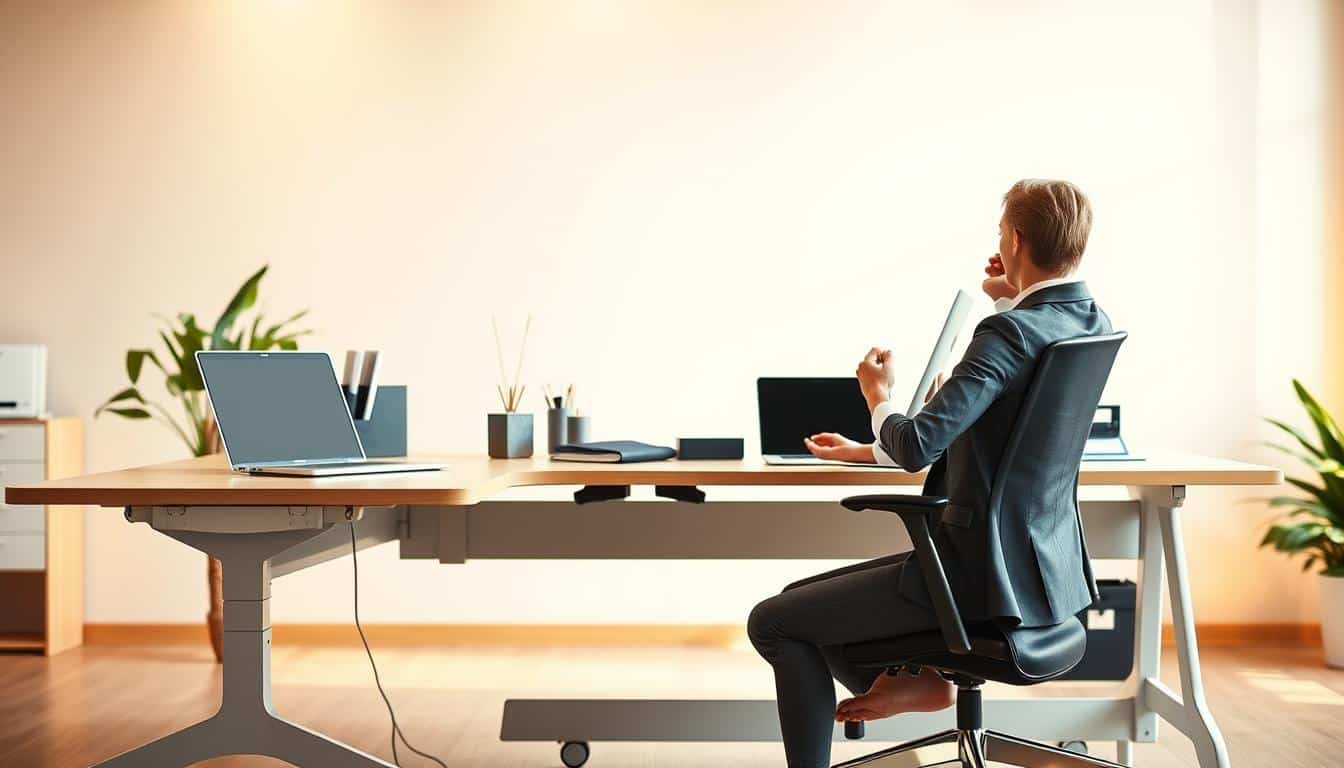Nowadays, adults often sit at desks for about 6.5 hours every day. This can lead to health problems like obesity and more stress. But, adding simple stretches while sitting at work is crucial. These stretches help us feel better right away. They make us more comfortable, focused, and energetic all day.
Doing certain stretches while sitting can lessen body tension. This makes workplace challenges easier to manage. Studies show that physical activities, such as stretching, can cut pain by up to 72 percent. They also make movement easier and improve posture. We’ll look into effective stretches that reduce stress and energize your workday. These can create a healthier and more efficient work environment.
Introduction to Workplace Stress
Workplace stress is a big problem for workers in many fields. The challenge of meeting deadlines and managing heavy workloads can be too much. It’s key to spot these stress triggers. Recognizing stress at work is the first step to deal with it well. Ignoring this stress can harm your health in the long run.
Long-term workplace stress can lead to anxiety, being very tired, and not doing well at work. If employees ignore their stress, they might work less well and feel worse overall. It’s crucial to handle stress well to keep a healthy work environment.
Adding exercise and mindfulness to your day can help manage stress. Even simple actions, like stretching in your seat or taking short breaks to move, can make a big difference. Making these habits a priority can create a better work atmosphere. It helps workers take charge of their health.
Understanding the Impact of Prolonged Sitting
Sitting too much can harm your health. It leads to obesity, type 2 diabetes, and heart diseases. Spending lots of time sitting, like more than eight hours a day, can be as dangerous as smoking.
Studies with over a million people show sitting too much can shorten your life. It messes with your metabolism and makes it hard for your body to regulate blood sugar and break down fat. This means you’re more at risk for chronic diseases. Many adults sit for up to nine hours a day doing things like watching TV, using computers, or driving.
To fight the dangers of sitting all day, add more movement to your life. Use standing desks, have walking meetings, and take breaks to stretch. Doing activities like fast walking or cycling for 60 to 75 minutes a day can help cancel out sitting’s bad effects.
The way we sit at work also poses risks to our health. Bad sitting postures can hurt your back and cause discomfort. For example, bus drivers have double the heart attack risk compared to active jobs. Making changes to reduce sitting time is crucial for better health.
The Importance of Movement in the Workplace
Moving more at work is key to keeping employees healthy. The World Health Organization points out that not moving enough is a top reason for early death worldwide. Also, sitting too much costs healthcare $24.7 billion every year. It’s clear we need to get moving at work.
Taking short breaks for some action helps fight muscle pain and makes you more alert and energetic. Just a little stretch or a quick walk can boost blood flow. This brings more oxygen and nutrients throughout your body, ditching toxins that make you tired and uncomfortable. Stretching regularly during these breaks lifts your mood and makes you work better.
Bosses can make a big difference by setting up workspaces that are good for your body, like chairs and desks that help you sit right. They should encourage breaks for moving around, maybe taking the stairs for a change. This can clear your head and spark new ideas. These actions help with sitting straight, feeling less tired, and staying mentally healthy too.
Moving affects our bodies in great ways, like better immune health and handling health troubles like inflammation or muscle aches better. Mixing sitting with standing at work, plus doing easy exercises at your desk like arm circles, shoulder shrugs, and leg raises, helps keep muscles working and happy.
Adding movement into our workday makes a workplace that loves being active, leading to more work done and happier workers. Doing things like walking while having meetings or standing during calls promotes a lively way of working and betters the workplace vibe.
Sitting Stretches for Immediate Relief
Sitting stretches are a quick way to reduce tension from sitting too long. By doing simple neck, upper back, and general sitting stretches, you’ll be more comfortable and productive. These stretches fit perfectly into any office schedule.
Neck and Shoulder Stretches
Neck stretches ease tightness and prevent pain from sitting too much. For the Ear-to-Shoulder stretch, sit up straight. Then gently tilt your head toward your shoulder and hold for 15 seconds on each side. The Chin-to-Chest stretch, where your chin goes down to your chest for 15 seconds, helps too. An Active Shoulder Roll can also ease shoulder tightness. Doing these regularly fights off tension headaches and improves your posture.
Upper and Lower Back Stretches
Upper back stretches keep your spine flexible. Try a seated twist and forward bends to relax your back. These stretches make you more flexible and boost your blood flow. This helps you stay alert and fights tiredness at work.
Leg and Hip Stretches
Leg and hip stretches improve blood flow in your lower body. Try a seated hamstring stretch to lessen tightness. The seated figure-four stretch does wonders for your hips. Adding these to your daily schedule helps keep you flexible and mobile. It’s smart to take short breaks every 30 minutes for quick stretches. This keeps your energy up.
Visualization Techniques for Stress Relief
Visualization techniques help you handle work stress by imagining a break from it all. They make you more aware and let you use your imagination to relax and see things clearly. Using these methods brings calm and helps control emotions, which is key when things get busy.
Creating a Mental Escape
Imagining a safe place can create a peaceful retreat in your mind during tough times. This method lowers stress by making you feel relaxed. Color breathing also helps by making you think of soothing colors, which cuts down on worry and makes emotions stable. Loving-kindness meditation builds kindness and positive feelings, helping you feel better about yourself at work.
Connecting to Your Senses
Using visualization with positive statements can really lift your confidence and reduce your stress. Remembering happy times or imagining success boosts how you see yourself. Body scan meditation is great for relaxing and easing the stiffness from sitting too long. It goes well with tensing and relaxing muscles for total calm, touching on both mind and body stress.
Guided imagery is strong against anxiety. For example, picturing quiet rainforests or calm beaches takes you away from what stresses you. Practicing these visualization steps, like seeing yourself meet your goals, lays the groundwork for less stress, positive vibes, and belief in yourself.
The Benefits of Deep Breathing
Deep breathing is a strong way to reduce stress. It helps people handle the stresses of daily life better. Learning how to breathe deeply lets people use different techniques for better health. This simple method can lower tension and make you feel more balanced emotionally.
Understanding Breathing Mechanisms
Deep breathing exercises help you relax and cut down on stress. Knowing how to breathe from your diaphragm is key. When you breathe in deeply through your nose and let your belly expand, and then breathe out slowly through your mouth, it works wonders. This process improves oxygen flow and balances blood pressure, decreasing it by about 6 mmHg on average.
Incorporating Deep Breathing Throughout the Day
Adding deep breathing to your day can boost your focus and control over your emotions. Taking short breaks to breathe deeply is easy. You can use apps on your phone or join programs at work. These methods help fight the stress and sitting too much that many people face at work. By doing this regularly, you can feel less anxious and tired. This leads to being more productive and feeling better overall.
Humor as a Stress Relief Mechanism
Using humor every day is a key way to ease stress. Laughter makes an area lively, helps relax, and cuts down stress. This is very important in today’s busy work life. Knowing why laughter helps and finding fun in daily life can make you feel better overall.
The Science Behind Laughter
Laughing causes body reactions that help lessen stress. It boosts oxygen flow, kicks organs into gear, and helps you relax. Laughter first fires up and then cools down your stress response, making you chill out. It also gets your blood moving, helps your muscles unwind, and eases stress-related body issues.
Studies show laughing lowers cortisol, a stress hormone. Watching funny videos can drop cortisol levels a lot. Laughing also works like a pain reliever. It helps with discomfort that comes from stress.
Finding Humor in Everyday Situations
Finding funny moments in daily life can make relationships stronger and workplaces happier. Laughing more can help you deal with struggles, lift your spirits, and grow your confidence. You can try to follow humorous meme pages, hang out with your pets, or try laughter yoga.
Doing fun activities helps people at work bond and feel happier about their jobs. Planning fun activities like game nights or group movie watching helps make a space where everyone can relax together.
Incorporating Movement into Your Day
Staying active while at work can make you healthier and more productive. Moving around helps your blood flow, digestion, flexibility, and your thinking. By doing simple exercises at your desk or taking short breaks, your workday can become more lively and fun.
Desk Exercises to Keep You Energized
Adding exercises during your workday combats the downsides of sitting too long. You can easily do:
- Shoulder shrugs
- Neck rolls
- Seated leg lifts
- Wrist stretches
- Chair dips and wall sits
Exercises like these at your desk boost blood flow and ease stiffness. They also help you sit straighter and may even help you live longer. Moving regularly promotes a healthier way of living.
Scheduling Short Activity Breaks
Making time for short breaks keeps you focused and full of energy. Try taking breaks every half to one hour. Here are ways to add more movement to your day:
- Take a short walk while listening to a podcast.
- Stretch or do a quick yoga session.
- Park further from the entrance to increase steps.
- Drink more water to encourage regular bathroom breaks.
- Set hourly reminders to move or stretch.
- Engage in playful activities with pets or kids.
- Dance to your favorite songs during breaks.
- Utilize commercial breaks for quick movements.
- Opt for stairs instead of elevators.
- Walk during lunch breaks.
- Perform calf raises while waiting.
Adding these small changes can really improve your day. It boosts the time you spend moving, reduces sitting risks, and makes work better.

Using Music as a Mood Booster
Music is a powerful way to boost your mood and fight stress. It can make you feel better emotionally. For instance, music can cut stress markers in your body by as much as 61%, a study in Frontiers in Psychology shows. This shows how music therapy can help us feel better and work better.
Putting music into our workdays brings many advantages. Music that has 60 beats per minute can help us relax by making our brain produce alpha waves. It’s great for stress relief on busy days. Also, calming music like classical music can lower stress by up to 74%. It’s perfect for making the office more peaceful.
To make the most out of music, create your own playlists. Choose songs that fit or boost your mood at different times. Even just 15 minutes of calming music can make you feel much better. Talking about song lyrics that you love with coworkers can strengthen your bond and create a supportive atmosphere at work.
Trying out various music styles can widen your music tastes and find what emotionally touches you. Playing an instrument or sharing a song you love can spark your creativity. It can also ease stress when things get tough. This way, music becomes key to a well-rounded approach to wellness at work.
Why Regular Stretching Matters
Stretching is crucial for good health, especially for those who sit a lot at work. It improves posture and boosts energy. This leads to a more active and focused team. Adding stretching to the daily routine helps keep everyone healthy and prevents injuries from stiff muscles.
The Ripple Effect on Posture and Energy Levels
Stretching regularly makes you more flexible and improves how your joints move. People working in offices often get tight muscles in their neck, shoulders, and lower back. Stretching these parts can stop injuries and help you keep a good posture all day.
Starting with a 5 to 10-minute warm-up gets your body ready to stretch safely. Holding stretches for about 30 seconds is a gentle way to ease the pain of sitting long hours.
Integrating Stretching into Office Culture
Encouraging stretching at work helps employees and boosts team spirit. Taking short breaks to stretch brings people together and builds teamwork. Adding movement activities like dynamic warm-ups and foam rolling can make you move better and feel less stiff.
Experts recommend stretching important muscles at least 2-3 days a week. This keeps everyone flexible and full of energy during the workday.
Creating a Habit of Daily Stretches
Making stretching a daily habit can improve your health at work. Adding stretches to your daily routine boosts flexibility and eases the pain from sitting too long. You can start by setting reminders and goals to make stretching part of your day.
Setting Reminders and Goals
Using reminders helps make stretching a regular part of your day. Plan specific times to stretch to keep flexible and comfortable. You can:
- Use smartphone alarms as reminders.
- Make a weekly stretching plan with goals.
- Do group stretches with coworkers.
Encouraging Team Participation
Stretching together at work can make everyone healthier. It builds team spirit and keeps everyone motivated. To get started:
- Take short stretch breaks in meetings.
- Create a ‘stretch club’ for regular sessions.
- Offer rewards to teams who stick to their goals.
When everyone stretches together, it makes the workplace healthier. This approach boosts both health and team productivity.
Conclusion
It’s crucial to blend office stretches and stress relief into our workdays for better health. Knowing about the risks of sitting too long helps us work better and stay healthy. Adding exercises like the jack-knife stretch makes us more flexible and fights work stress.
Stretching regularly is good for us, showing clear health benefits. Improving how we sit and keeping aware of our posture lessens pain. Mindfulness and regular stretching make us happier and work better.
Making office stretches a habit improves our work life and health. Even short breaks for stretching make a big difference in our day. Seeing stretching as important keeps our minds and bodies healthy, leading to a happier workplace.



